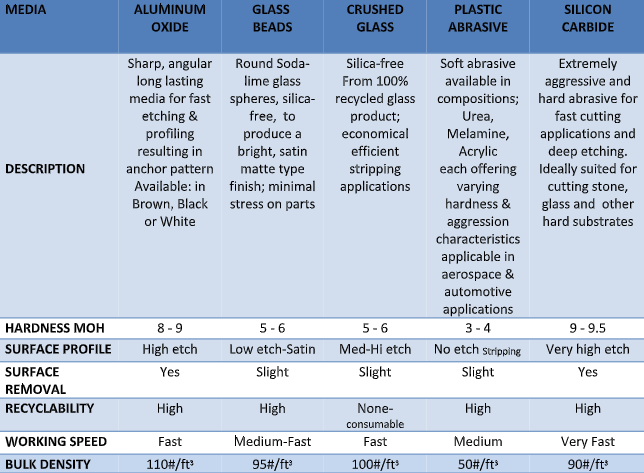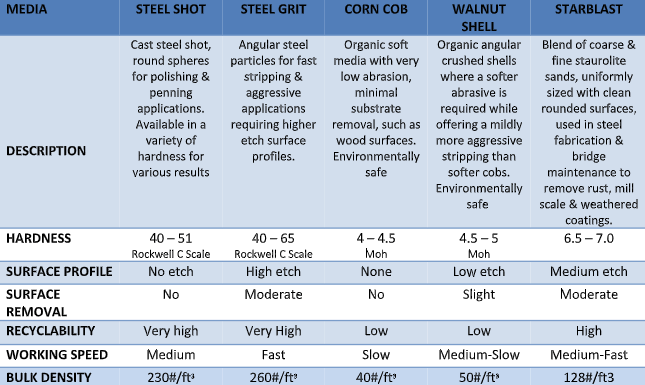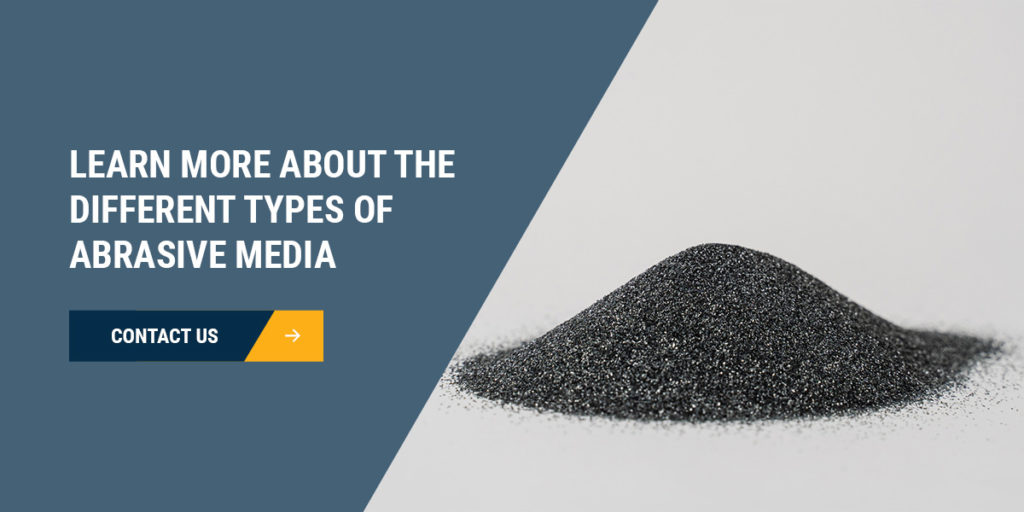Types of Abrasive Materials
March 07, 2023Workpieces made of metal frequently contain natural or man-made impurities and defects. These imperfections can complicate the application of coatings or hinder other critical processes, potentially compromising the final product's quality.
Abrasives play a crucial role in surface preparation by effectively eliminating contaminants and preparing the surface for subsequent stages of production. This process typically involves propelling high-pressure water mixed with abrasives to remove dirt, grease, chemicals, and other residues, achieving the desired finish.
There are numerous types of abrasive materials, commonly referred to as media, each with distinct advantages and drawbacks. Choosing the right abrasive is essential for optimizing the surface preparation process and ensuring the desired outcome.
What Are the Different Types of Abrasive Media?
Let’s explore some of the most common abrasive media types, along with their descriptions and typical applications:

- Glass Beads: Glass abrasive is less aggressive compared to other materials like steel shot or silicon carbide. It’s ideal for applications requiring a softer, brighter finish, especially for stainless steel surfaces. Glass beads can be recycled multiple times, adding to their cost-effectiveness.
- Aluminum Oxide: Known for its exceptional hardness and durability, aluminum oxide is widely used in anti-slip surfaces, industrial blasting, and as a component in refractory materials. It is versatile enough to handle various substrates, including glass, granite, marble, and steel. Its strong etching capabilities make it suitable for surface preparation before painting or applying coatings.
- Plastics: Plastic abrasives are made from crushed urea, polyester, or acrylic and come in varying hardness levels and particle sizes. They are considered optimal for mold cleaning, blasting plastic parts, or situations where the substrate must remain intact. Industries such as automotive, aviation, boating, electronics, and industrial sectors commonly use plastic media blasting.

- Silicon Carbide: As the hardest abrasive material available, silicon carbide is ideal for demanding surface finishing tasks. Available in various colors and purities, it is used in bonded abrasive tools, lapping, polishing, glass etching, and heavy-duty blast cutting applications.
- Steel Shot & Grit: Steel abrasives are a cost-effective alternative due to their toughness and high recyclability. They are effective in removing contaminants, texturing surfaces for proper coating adhesion, and peening (hardening). Selecting the appropriate size, hardness, and shape is critical for successful media selection.
- Starblast: Starblast is a mixture of coarse and fine staurolite sands with minimal silica content, making it a versatile general-purpose blasting abrasive. It efficiently removes scale and rust from steel surfaces while maintaining low dust levels for better visibility.
- Walnut Shells: Walnut shell abrasive is a durable natural material derived from crushed walnut shells. It is the harder of the soft abrasives, available in various sizes for cleaning and polishing softer surfaces without causing damage. Common uses include polishing soft metals, fiberglass, wood, plastic, and stone, as well as in tumbling operations for gemstones and jewelry.
- Corn Cobs: Corn cob abrasive is produced by crushing the woody part of corn cobs into different grit sizes. It is the softer of the naturally occurring abrasives, making it perfect for cleaning, deburring, burnishing, and de-flashing. Industries such as jewelry, cutlery, engine parts, fiberglass, and graffiti removal benefit from its gentle action.
The Evaluation Criteria
When selecting abrasive media, it’s essential to evaluate the following characteristics to ensure the best performance for your project:
- Hardness: Determined by the Mohs Hardness Scale, this measures the material’s scratch resistance on a scale from 1 to 10. Higher ratings indicate greater scratch potential, which is vital when working with softer substrates.
- Surface Profile: The size, shape, hardness, and density of the abrasive influence the profile it creates on the surface, resulting in a no, low, medium, or high etch.
- Surface Removal: Understanding how much of the substrate’s surface the abrasive will remove ensures the result aligns with project specifications.
- Recyclability: For businesses focused on cost reduction, recyclable materials are a key consideration for minimizing waste and maximizing efficiency.
- Processing Speed: Some abrasives allow for faster completion of the blasting process, which can be beneficial for time-sensitive projects.
- Bulk Density: Measured in pounds per cubic foot, the abrasive’s density affects its cleaning rate and the surface profile it leaves behind.
Learn More About the Different Types of Abrasive Media
Finishing Systems offers a wide range of sandblast media types for purchase. Our products come in various grit sizes and packaging options to cater to your specific needs. Each material delivers consistent quality and performance, helping you achieve optimal results for your projects.
Need help choosing the right abrasive media? Our team at Finishing Systems has the expertise to guide you through the selection process and ensure you make an informed decision.
Contact us today for more information or to address any questions you may have about abrasive media.

Can Beer ,beverage Filling Machine
King Whale Machinery Group J.S , https://www.baitextile.com